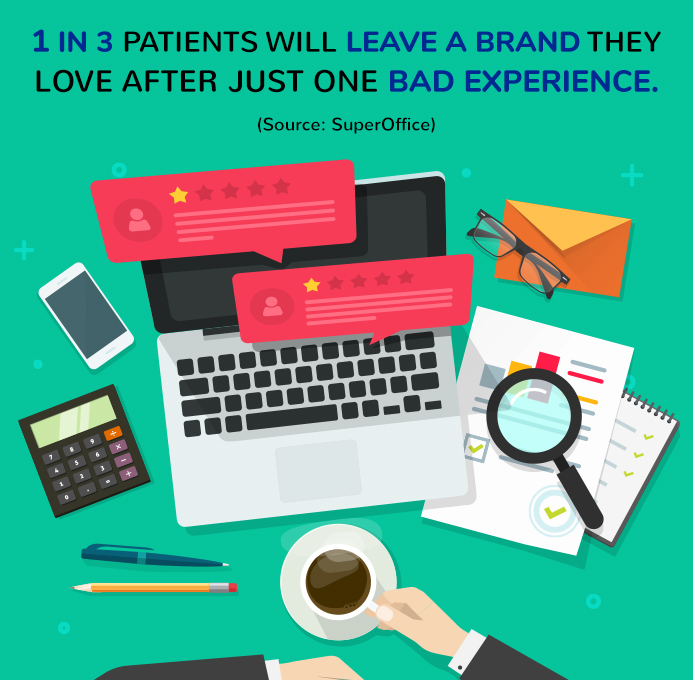5 Strategies to Improve Patient Experience
Posted on
In the competitive landscape of healthcare, patient experience plays a pivotal role in shaping the success and reputation of medical practices. Understanding the significance of patient experience in healthcare is crucial for building trust, satisfaction, and fostering long-term relationships. In this guide, Practice Builders will help you explore key strategies to enhance the patient experience and why it matters so much.
Create and calculate an engaging online presence
In the digital age, having a strong online presence is crucial for medical practices to attract and engage patients. A well-designed website with clear information about services, staff, and facilities is essential for building trust. A user-friendly website not only enhances the practice’s professional image but also serves as a valuable tool for patient education. Regular updates and optimizations are required to keep the website reliable and in line with evolving healthcare standards. Ultimately, a good online presence contributes to improving the overall patient experience.
Measuring patient experience is integral to enhancing healthcare services. The calculation of patient satisfaction involves gathering feedback from patients and gauging their perceptions and feelings about their healthcare experience. Patient experience surveys serve as a valuable tool to collect this information, providing insights into the overall satisfaction levels of patients. The patient satisfaction score, a key metric in this process, reflects the collective sentiment regarding the quality of treatment and healthcare received. Utilizing various rating scales, such as 5-point scales or smiley surveys, patients can express their satisfaction levels. To calculate the patient satisfaction score (CSAT), one must find the average of all ratings using the formula:
CSAT = Sum of all Ratings/Sum of Maximum Scores x 100.

This systematic approach empowers healthcare providers to gauge patient satisfaction accurately, facilitating continuous improvements and a patient-centric approach to care.
It’s crucial to note that a negative experience can quickly harm a healthcare practice’s brand image in the digital age, underscoring the importance of consistently delivering positive interactions to maintain a favorable reputation.

Why patient experience is important
A compelling online presence sets the stage for a positive patient experience by providing transparency and easing apprehensions. Testimonials from current patients add authenticity, helping to build trust right from the beginning.

To improve your healthcare practice’s online visibility, claim and update your information on platforms like Google My Business and third-party review sites. Maintaining a consistent NAP (name, address, and phone number) on these sites enhances credibility and accessibility. Claiming your business on Google My Business ensures accurate information is displayed, while managing third-party review sites allows for transparency and customer satisfaction. This not only builds trust with patients but also streamlines the user experience, enhancing patient engagement and accessibility in the digital landscape.
Effective communication is the key element of a positive patient experience, from the first point of contact to post-appointment follow-ups.
- Make listening to patients a top priority.
- Implement a system to collect patient feedback.
- Use patient feedback to understand your patients.
- Solve patients’ problems promptly.
Cultivate a patient-centric communication culture within your practice to establish a strong foundation for patient relationships.
Improving Patient Experience Through Communication

A positive patient experience is dependent on effective communication. Patients can be kept aware and involved through staff training, one-on-one conversations, and regular updates. A friendly environment is created by making eye contact, grinning, and politely greeting others. Being open and honest about appointment delays shows trust. The patient-provider relationship is strengthened when in-depth conversations regarding healthcare issues are encouraged. Healthcare practitioners should make themselves accessible outside of regular appointment hours. Providing a variety of avenues for communicating and interacting with patients on different platforms enhances their entire experience. By putting these tactics into practice, an environment that is patient-centered can be created, encouraging contentment, trust, and a favorable effect on the patient’s healthcare journey.

Importance of Accessibility in Patient Experience
Encouraging accessible avenues of communication, such as SMS and phone conversations, is essential to improving patient satisfaction. Encouraging patients to get in touch outside of regular business hours is essential to improving the patient experience. By providing a simple and safe platform for queries, the implementation of secure messaging systems can further streamline contact between patients and healthcare professionals. In order to promote a feeling of connection and concern, it is crucial to emphasize the significance of responsiveness in all encounters.
Furthermore, enhancing the patient experience necessitates both clear communication and a thorough comprehension of the patient’s path. This is a path that begins with the recognition of a health problem and ends with follow-ups after therapy. Healthcare professionals can customize experiences to match individual requirements by outlining and recognizing each stage of the patient journey. This ensures a more individualized and encouraging approach to patient care. In the end, these initiatives support a patient-centered setting that fosters trust, confidence, and successful outcomes throughout the healthcare process.

Mapping the Patient Journey
Patient journey mapping is a strategic tool that involves the visualization and analysis of every stage in a patient’s interaction with your healthcare practice. This process aims to identify touchpoints and potential pain points throughout the patient’s experience, enabling you to streamline processes and address areas for improvement.
You can improve communication, make processes run faster, and provide more individualized treatment by thoroughly mapping the patient path and gaining insightful knowledge about the entire patient experience. Finding and fixing pain points—whether they have to do with waiting times, appointment scheduling, or communication breakdowns—is essential to using patient journey mapping successfully. By making these focused changes, you can give patients a more enjoyable and seamless experience, which will boost their loyalty and happiness. Optimizing the patient experience ultimately puts your practice in a better position to develop since happy patients are more likely to refer others to you, which increases referrals and good word-of-mouth.
Strategies to improve the patient experience
1. Understand Your Target Audience
Tailoring healthcare services to the specific needs of your patient demographic is crucial. By understanding the unique preferences and challenges of your target audience, healthcare providers can personalize their approach, creating a more empathetic and patient-centric environment.
2. Create a patient-focused vision
Establishing a clear vision centered around patient well-being sets the tone for a healthcare organization. When every staff member is aligned with a patient-focused vision, it creates a culture that prioritizes compassionate care and emphasizes the importance of the overall patient experience.
3. Gather patient feedback
Patient feedback serves as a valuable tool for improvement. Actively seeking and listening to patient opinions helps identify areas that require attention and refinement. Embracing a continuous feedback loop ensures that healthcare providers stay responsive to the evolving needs and expectations of their patients.
4. Replace marketing with patient service
While marketing efforts are essential, placing a greater emphasis on delivering exceptional patient service speaks volumes. Genuine care and attention during every interaction, from appointment scheduling to discharge, contribute significantly to the overall patient experience.
5. Measure the ROI from delivering a great patient experience
Quantifying the return on investment (ROI) from efforts to enhance patient experience is a critical step. By analyzing metrics such as patient satisfaction scores, reduced readmission rates, and increased patient referrals, healthcare providers can gauge the impact of their initiatives and make data-driven improvements.
Conclusion
In the competitive realm of healthcare, prioritizing patient experience is a strategic decision that can set your practice apart. The best healthcare marketing agency Practice Builders will help you with creating an engaging online presence, fostering effective communication, ensuring accessibility, and understanding the nuances of the patient journey. By implementing these strategies, medical practices can build stronger patient relationships, improve satisfaction rates, and ultimately thrive in an increasingly patient-centric healthcare landscape.

 What Are the First Steps When Planning a New Websi..
What Are the First Steps When Planning a New Websi.. SEO Strategies to Rank Your Dental Practice
SEO Strategies to Rank Your Dental Practice How AI is Driving Patient Engagement and Revolutio..
How AI is Driving Patient Engagement and Revolutio..